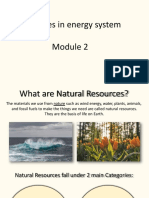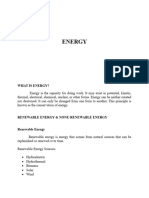0 ratings0% found this document useful (0 votes)
36 viewsSources of Energy
Sources of Energy
Uploaded by
Mike Jacson BautistaEnergy and power can come from many sources. Energy is the ability to do work or transfer heat, and is measured in joules, while power is the rate of energy transfer and is measured in watts. Common energy sources discussed include fossil fuels like oil and gas, renewable sources like solar, wind, hydroelectric, geothermal, and biofuels from biomass. Nuclear energy also generates power through fission reactions.
Copyright:
© All Rights Reserved
Available Formats
Download as PDF, TXT or read online from Scribd
Sources of Energy
Sources of Energy
Uploaded by
Mike Jacson Bautista0 ratings0% found this document useful (0 votes)
36 views26 pagesEnergy and power can come from many sources. Energy is the ability to do work or transfer heat, and is measured in joules, while power is the rate of energy transfer and is measured in watts. Common energy sources discussed include fossil fuels like oil and gas, renewable sources like solar, wind, hydroelectric, geothermal, and biofuels from biomass. Nuclear energy also generates power through fission reactions.
Original Title
sources of energy
Copyright
© © All Rights Reserved
Available Formats
PDF, TXT or read online from Scribd
Share this document
Did you find this document useful?
Is this content inappropriate?
Energy and power can come from many sources. Energy is the ability to do work or transfer heat, and is measured in joules, while power is the rate of energy transfer and is measured in watts. Common energy sources discussed include fossil fuels like oil and gas, renewable sources like solar, wind, hydroelectric, geothermal, and biofuels from biomass. Nuclear energy also generates power through fission reactions.
Copyright:
© All Rights Reserved
Available Formats
Download as PDF, TXT or read online from Scribd
Download as pdf or txt
0 ratings0% found this document useful (0 votes)
36 views26 pagesSources of Energy
Sources of Energy
Uploaded by
Mike Jacson BautistaEnergy and power can come from many sources. Energy is the ability to do work or transfer heat, and is measured in joules, while power is the rate of energy transfer and is measured in watts. Common energy sources discussed include fossil fuels like oil and gas, renewable sources like solar, wind, hydroelectric, geothermal, and biofuels from biomass. Nuclear energy also generates power through fission reactions.
Copyright:
© All Rights Reserved
Available Formats
Download as PDF, TXT or read online from Scribd
Download as pdf or txt
You are on page 1of 26
Energy is the capacity to do some physical
activities or work, such as running, jumping,
etc., while power is defined as the rate at
which the energy is transferred, or the work
is completed. The unit used to measure
energy is joules, ergs and calories. Power is
measured in watts.
What is power and energy in electrical?
• Electric power is the rate at which a
device changes electric current to another
form of energy. The SI unit of power is the
watt. Electric power can be calculated as
current times voltage. Electrical energy
use equals the power of the appliance
multiplied by the amount of time the
appliance is used.
Why is power and energy important?
• We use energy to not only heat our
human-made structures but we use it to
cool them as well. Energy is necessary for
getting up out of bed, walking down the
street, or even lifting your finger. It's also
necessary in abundance for all types of
modern conveniences, from light bulbs to
appliances to vehicles.
Forms of energy
Many forms of energy exist, but they all fall
into two basic categories:
Potential energy
Potential energy is stored energy and the
energy of position.
Kinetic energy
Kinetic energy is the motion of waves,
electrons, atoms, molecules, substances,
and objects.
Biomass
• Biomass includes the use of food and wood.
Energy stored in non-fossil organic materials
such as wood, straw, vegetable oils and wastes
from the forest, agricultural and industrial
sectors. Biomass is captured from forest
industries. To capture energy from biomass is to
burn it, to make heat, steam, and electricity.
Fossil Fuels
• Fossil Fuels include different types of oil, gas
and jet fuel. They are normally ‘natural
resources’ and are extracted from the earth
itself. Non-renewable resources. Fossil Fuels
may also be associated with mineral fuels. The
resources may be crushed, burnt, or turned into
steam.
• Fossil Fuels form from the organic remains of
prehistoric plants and animals.
Hydroelectric Energy
• Hydroelectric Energy produces energy
through power plants, some such as; Micro-
scale, small-scale and “run-of-the-river.” A dam
is built to trap water, usually in a valley where
there is an existing lake. Water is allowed
to flow through tunnels in the dam, to turn
turbines and thus drive generators. Notice that
the dam is much thicker at the bottom than at
the top, because the pressure of the water
increases with depth.
• Hydro-electric power stations can produce a
great deal of power very cheaply.
Nuclear Energy
• Nuclear Energy work by thermal nuclear
reactors and fast reactors. The thermal ones use
a moderator to slow down the neutrons
produced by fission. The moderator can be
normal water, heavy water, or graphite. The
normal water types are the Pressurized Water
Reactor and Boiling Water Reactor. Fast reactors
don't have a moderator, and therefore cannot
be built with a water filled core, so have used
liquid metal, usually sodium, as coolant.
Solar Energy
• Solar Energy, radiant light and heat from the sun, has
been harnessed by humans since ancient times using a
range of ever-evolving technologies. Solar powered
electrical generation relies on heat engines and
photovoltaic. Solar energy's uses are limited only by
human ingenuity.
A partial list of solar applications includes space heating
and cooling through solar architecture, potable water via
distillation and disinfection, day lighting, solar hot water,
solar cooking, and high temperature process heat for
industrial purposes. To harvest the solar energy, the
most common way is to use solar panels.
Wind Energy
• Wind energy is energy obtained from moving
air. is the conversion of wind energy into a
useful form of energy. Some such as using wind
turbines to make electricity, wind mills for
mechanical power, wind pumps for pumping
water or drainage, or sails to propel ships.
• The motion results from the heating and cooling
of the Earth.
• Flowing wind can be used to
turn turbines for the
generation of electricity.
• A typical wind tower consists
2 to 3 blades which turn a
shaft increasing rotation
speed and converting into
electrical energy.
Geothermal Energy
• Geothermal Energy is power extracted from
heat stored in the earth. Geothermal power is
cost effective, reliable, sustainable, and
environmentally friendly, but has historically
been limited to areas near tectonic plate
boundaries.
• This geothermal energy originates from the
original formation of the planet, from radioactive
decay of minerals, and from solar energy
absorbed at the surface.
Bio Fuel
• Biofuel, alternative
source of energy, has
been used to replace
conventional fuels.
• Biofuels are renewable
sources of energy
produced from
biological materials
such as sugarcane,
corn, cellulose or
vegetable oils.
Bio Fuel
Ethanol and biodiesel are
common biofuels.
Ethanol can be used as a
direct source of energy and
combined with gasoline to
produce effective results.
• Biodiesel is a
biodegradable fuel which
can replace traditional
diesel fuel.
• Technology has been
developed to use algae
as a biofuel.
You might also like
- The Perfect Answer Physics Revision Guide - Edexcel IGCSE 9-1 - 1st EditionDocument34 pagesThe Perfect Answer Physics Revision Guide - Edexcel IGCSE 9-1 - 1st EditionKevir Man83% (6)
- Topic 8 Problem Set Answer KeyDocument6 pagesTopic 8 Problem Set Answer KeyTop Quality Sounds Arcia100% (1)
- Renewable Energy Basics BGDocument6 pagesRenewable Energy Basics BGErwin NurrizkiNo ratings yet
- The Sources of Energy: Grade 3 2020-2021Document15 pagesThe Sources of Energy: Grade 3 2020-2021IvanNo ratings yet
- Sona 17CIVBE109 SE435430018070Document25 pagesSona 17CIVBE109 SE435430018070Tara Chandra PanjiyarNo ratings yet
- Introduction Renewal Energy Resources (IIT-BHU)Document33 pagesIntroduction Renewal Energy Resources (IIT-BHU)samarth singhNo ratings yet
- Unit Energy Part 5Document20 pagesUnit Energy Part 5Maurya AdeshraNo ratings yet
- Renewable Non Renewable Energy ResourcesDocument17 pagesRenewable Non Renewable Energy Resourcesmanuelsantos2007No ratings yet
- Week 11 Energy in ChemistryDocument31 pagesWeek 11 Energy in ChemistryJay celvin alvaroNo ratings yet
- How Energy Is Produced and ManagedDocument21 pagesHow Energy Is Produced and ManagedAmiel ObusanNo ratings yet
- SeminarDocument12 pagesSeminartalla bhargava venkata sudheerNo ratings yet
- Alternative Energy ResourcesDocument18 pagesAlternative Energy ResourcesGenelyn RodriguezNo ratings yet
- UntitledDocument29 pagesUntitledLovely Quevedo ʚĩɞNo ratings yet
- Sources of Energy ScriptDocument15 pagesSources of Energy ScriptShah ChenzenNo ratings yet
- Renewable Energy: Presented By: Jatin Meghlan Piyush Singh ChiraghDocument26 pagesRenewable Energy: Presented By: Jatin Meghlan Piyush Singh Chiraghjaazsingh100% (1)
- Energy SourcesDocument40 pagesEnergy SourcesRamil Cachuela100% (3)
- Physical Science Lesson 7 About Source of Energy Week lesson-7-Sources-of-Energy (1) Physicabl ScienceDocument35 pagesPhysical Science Lesson 7 About Source of Energy Week lesson-7-Sources-of-Energy (1) Physicabl SciencereneicrizaldoNo ratings yet
- Physics PPT - 1Document23 pagesPhysics PPT - 1SaturnNo ratings yet
- Boiler PPT - IIDocument286 pagesBoiler PPT - IIgrittyptNo ratings yet
- Energy of Moving WaterDocument64 pagesEnergy of Moving WaterBetty Blue0% (1)
- Sources of EnergyDocument34 pagesSources of EnergyKarthika UmashankarNo ratings yet
- ProjectDocument4 pagesProjecttejasg0506No ratings yet
- Energy ResourcesDocument26 pagesEnergy ResourcesJepoy dizon Ng Tondo Revengerz gangNo ratings yet
- Renewable EnergyDocument11 pagesRenewable EnergyImtiaz HussainNo ratings yet
- EnergyDocument9 pagesEnergyIsmaksNo ratings yet
- 1 TEDC 2105 Electrical Energy Generation and UtilizationDocument35 pages1 TEDC 2105 Electrical Energy Generation and UtilizationKusiimaNo ratings yet
- Energy Engineering: Introduction To Energy, Energy Resources & Overview of Energy Demand (World & Pakistan)Document54 pagesEnergy Engineering: Introduction To Energy, Energy Resources & Overview of Energy Demand (World & Pakistan)Awais SalahuddinNo ratings yet
- Q4 Physical Science M1Document15 pagesQ4 Physical Science M1celesthaliaaNo ratings yet
- Types of Energy: Mechanical, Electromagnetic, Electrical, Chemical and ThermalDocument31 pagesTypes of Energy: Mechanical, Electromagnetic, Electrical, Chemical and ThermalHarkamal DhillonNo ratings yet
- Natural ResourcesDocument52 pagesNatural ResourcesJhon Franko GarciaNo ratings yet
- PhysciDocument27 pagesPhyscisophia lizarondoNo ratings yet
- Sources of EnergyDocument11 pagesSources of Energyahmadabdullahk45No ratings yet
- Energy: Work Heat Kinetic Mechanical Energy Light Potential Energy ElectricalDocument24 pagesEnergy: Work Heat Kinetic Mechanical Energy Light Potential Energy ElectricalfrazfarooquiNo ratings yet
- Energy SourcesDocument3 pagesEnergy SourcesFame Iverette GalapiaNo ratings yet
- Conventional: Energy That Has Been Used From Ancient Times Is Known As Conventional EnergyDocument4 pagesConventional: Energy That Has Been Used From Ancient Times Is Known As Conventional EnergyMarkAnthonyS.LopezNo ratings yet
- Energy ResourcesDocument36 pagesEnergy ResourcesHarjot KaurNo ratings yet
- Marine Propulsion Engines and Renewable Energies: NME 463 By: Dr. Waleed YehiaDocument33 pagesMarine Propulsion Engines and Renewable Energies: NME 463 By: Dr. Waleed YehiawaleedyehiaNo ratings yet
- RAJESH DAS at MECHANICAL at 4TH YEAR at RENEWABLE ENERGYDocument29 pagesRAJESH DAS at MECHANICAL at 4TH YEAR at RENEWABLE ENERGYNilanjon DasNo ratings yet
- Pertumbuhan Sumber Daya EnergiDocument72 pagesPertumbuhan Sumber Daya EnergiMuhamad Ghufron MusyafaNo ratings yet
- Energy Forms Lesson 2Document45 pagesEnergy Forms Lesson 2DomsNo ratings yet
- Sources of Energy Notes Specially HandwrittenDocument9 pagesSources of Energy Notes Specially Handwrittenjeevan krishnaNo ratings yet
- Natural Resources PowerPointDocument25 pagesNatural Resources PowerPointK RaghuNo ratings yet
- Unit 3A BeeeDocument15 pagesUnit 3A Beeejvharsha.sNo ratings yet
- Alternative Sources of Energy in DetailDocument22 pagesAlternative Sources of Energy in DetailPRIYA MISHRANo ratings yet
- Non Conventional Energy ResourcesDocument43 pagesNon Conventional Energy Resourcespandith9021No ratings yet
- Renewable EnergyDocument14 pagesRenewable EnergynextgenlowqualityNo ratings yet
- Renewable EnergyDocument38 pagesRenewable EnergyRahul Kumar100% (1)
- Aug 11Document15 pagesAug 11Allen GeorgeNo ratings yet
- Chapter 2.1 EnergyDocument40 pagesChapter 2.1 EnergyTeresa YanNo ratings yet
- Name of The Student Teacher: Optional Subject: Register No: Name of The CollegeDocument14 pagesName of The Student Teacher: Optional Subject: Register No: Name of The Collegem4rasiNo ratings yet
- Renewable Energy Sources: Dr. I. Jacob Raglend Professor School of Electrical EngineeringDocument32 pagesRenewable Energy Sources: Dr. I. Jacob Raglend Professor School of Electrical EngineeringSiddharth Jain 16BEE0276No ratings yet
- Document 3Document7 pagesDocument 3MMMddd yyrNo ratings yet
- Renewable Sources of Energy1Document18 pagesRenewable Sources of Energy1Arpit KapoorNo ratings yet
- Solar Energy: By:Kavi, Venkat, and KarthikeyaDocument12 pagesSolar Energy: By:Kavi, Venkat, and KarthikeyaStudy GuyNo ratings yet
- Las-Physical ScienceDocument5 pagesLas-Physical ScienceDainavi Lizarte Bayucan PalitayanNo ratings yet
- Other Types of TransducersDocument16 pagesOther Types of TransducersAllysa Marie CabralNo ratings yet
- CH 1 IntroductionDocument40 pagesCH 1 IntroductionMussa DemewezNo ratings yet
- Power Plant Engineering NotesDocument3 pagesPower Plant Engineering NotesNeelesh PandeyNo ratings yet
- Pre SEM 01Document92 pagesPre SEM 01Gerance Instruccion PipingNo ratings yet
- Sources of EnergyDocument40 pagesSources of EnergyHyacinth RaeNo ratings yet
- Renewable Energy Sources - Wave, Geothermal and Biomass Energy Edition : Environment Books for Kids | Children's Environment BooksFrom EverandRenewable Energy Sources - Wave, Geothermal and Biomass Energy Edition : Environment Books for Kids | Children's Environment BooksNo ratings yet
- Harvesting Solar, Wind and Tidal Power - Environment for Kids | Children's Earth Sciences BooksFrom EverandHarvesting Solar, Wind and Tidal Power - Environment for Kids | Children's Earth Sciences BooksNo ratings yet
- Ohms LawDocument31 pagesOhms LawMike Jacson BautistaNo ratings yet
- THEORY 1 Module 1 Study Guide A4 Aug12'20Document31 pagesTHEORY 1 Module 1 Study Guide A4 Aug12'20Mike Jacson BautistaNo ratings yet
- Unit 1: Various Perspectives of The SelfDocument10 pagesUnit 1: Various Perspectives of The SelfMike Jacson BautistaNo ratings yet
- College of Engineering and ArchitectureDocument1 pageCollege of Engineering and ArchitectureMike Jacson BautistaNo ratings yet
- DESIGN 1 Module 1 Study Guide A4 Aug12'20Document16 pagesDESIGN 1 Module 1 Study Guide A4 Aug12'20Mike Jacson BautistaNo ratings yet
- At The End of The Course, You Are Expected To:: Module TitleDocument3 pagesAt The End of The Course, You Are Expected To:: Module TitleMike Jacson BautistaNo ratings yet
- Module Title: at The End of The Course, You Are Expected ToDocument4 pagesModule Title: at The End of The Course, You Are Expected ToMike Jacson BautistaNo ratings yet
- Study-Guide-Part 1Document9 pagesStudy-Guide-Part 1Mike Jacson BautistaNo ratings yet
- Study-Guide-Part 3Document32 pagesStudy-Guide-Part 3Mike Jacson BautistaNo ratings yet
- Study-Guide-Part 2Document9 pagesStudy-Guide-Part 2Mike Jacson BautistaNo ratings yet
- Short Self Description 1 PDFDocument1 pageShort Self Description 1 PDFMike Jacson BautistaNo ratings yet
- THEORY 1 Course Guide 1 of 15Document4 pagesTHEORY 1 Course Guide 1 of 15Mike Jacson BautistaNo ratings yet
- Pangasinan State University College of Engineering and ArchitectureDocument1 pagePangasinan State University College of Engineering and ArchitectureMike Jacson BautistaNo ratings yet
- SAMPLE Research WorkDocument2 pagesSAMPLE Research WorkMike Jacson BautistaNo ratings yet
- DESIGN 1 Course Guide 1 of 11Document4 pagesDESIGN 1 Course Guide 1 of 11Mike Jacson BautistaNo ratings yet
- Psu TB 8.5x12 PDFDocument1 pagePsu TB 8.5x12 PDFMike Jacson BautistaNo ratings yet
- Mathematics in Our WorldDocument47 pagesMathematics in Our WorldMike Jacson BautistaNo ratings yet
- Technische Beschreibung KKL enDocument32 pagesTechnische Beschreibung KKL enapi-351853154100% (1)
- Candu Fundamentals20040700Document314 pagesCandu Fundamentals20040700giampierovalenti100% (1)
- Delhi University Non Teaching Previous Papers General ScienceDocument30 pagesDelhi University Non Teaching Previous Papers General Scienceनरोत्तमवत्सNo ratings yet
- Dreams of Nuclear FlightDocument23 pagesDreams of Nuclear FlightAlessandro CastelvetriNo ratings yet
- 1 Fission & The Neutron CycleDocument59 pages1 Fission & The Neutron CyclePeter ShankerNo ratings yet
- Lab 1 Manual - G1 Fermi AgeDocument13 pagesLab 1 Manual - G1 Fermi AgeCasey EricsonNo ratings yet
- Power Plant Engineering MCQs PDFDocument48 pagesPower Plant Engineering MCQs PDFkiran100% (2)
- Maraczy@sunserv Kfki HuDocument6 pagesMaraczy@sunserv Kfki Huzerodechet30No ratings yet
- Power GenerationDocument32 pagesPower GenerationSachidananda SwarNo ratings yet
- TR 108146Document216 pagesTR 108146FRANCISCO JOSE GARCIA IBAÑEZ100% (1)
- Nuclear Power PlantDocument12 pagesNuclear Power PlantHalifa AhmadNo ratings yet
- Unit 3A BeeeDocument15 pagesUnit 3A Beeejvharsha.sNo ratings yet
- MCQ PGTDocument17 pagesMCQ PGTmahajanpb2012No ratings yet
- Basic Mech - QN Bank - Part BDocument49 pagesBasic Mech - QN Bank - Part BrkumaravelanNo ratings yet
- Nuclear Power: Dr. M. SubramanianDocument33 pagesNuclear Power: Dr. M. SubramanianNkugwa Mark WilliamNo ratings yet
- Energy and Power Ib2Document24 pagesEnergy and Power Ib2Gkid GkidNo ratings yet
- Nuclear Power Plant: Course ContentsDocument15 pagesNuclear Power Plant: Course ContentsSheh NazNo ratings yet
- P. Von Der Hardt, H. Röttger (Auth.), P. Von Der Hardt, H. Röttger (Eds.) - Neutron Radiography Handbook - Nuclear Science and Technology-Springer Netherlands (1981)Document179 pagesP. Von Der Hardt, H. Röttger (Auth.), P. Von Der Hardt, H. Röttger (Eds.) - Neutron Radiography Handbook - Nuclear Science and Technology-Springer Netherlands (1981)Kingston RivingtonNo ratings yet
- Neutron Radiation TestingDocument8 pagesNeutron Radiation TestingVINAYNo ratings yet
- Fundamentals of Nuclear Power Generation. Basics of VVER TechnologyDocument25 pagesFundamentals of Nuclear Power Generation. Basics of VVER TechnologyNafis FuadNo ratings yet
- Physics MCQ Chapter 19Document2 pagesPhysics MCQ Chapter 19Data Number 4No ratings yet
- Introduction To Nuclear Reactors, Fuels, and Materials: Heather J. Maclean Chichester, PH.DDocument62 pagesIntroduction To Nuclear Reactors, Fuels, and Materials: Heather J. Maclean Chichester, PH.Dopenid_AePkLAJcNo ratings yet
- Power Plant Instrumentation - TsDocument205 pagesPower Plant Instrumentation - TsGrishma Warke100% (1)
- Nuclear Physics: 8.1 NucleusDocument48 pagesNuclear Physics: 8.1 NucleusJanani PillaiNo ratings yet
- Group - 3 - Fuel Conversion, Enrichment and FabricationDocument18 pagesGroup - 3 - Fuel Conversion, Enrichment and Fabricationjahid imranNo ratings yet
- NUEN 605 Laboratory #7: Uranium Mass Measurement Using He Neutron DetectorsDocument11 pagesNUEN 605 Laboratory #7: Uranium Mass Measurement Using He Neutron DetectorsAshraf ZoubiNo ratings yet
- Unit 2 CONVENTIONAL ENERGY UpdatedDocument96 pagesUnit 2 CONVENTIONAL ENERGY UpdatedSOWMI C SNo ratings yet








































































































